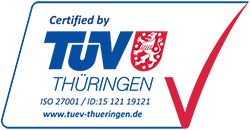Check .lt domain
The national .lt domain turns 30: how Lithuania’s internet was born
This year marks the 30th anniversary of the Lithuanian national domain since 1992 when the .lt domain was created online at the request of the University of Oslo with the support of the Government of Norway. The first domains mii.lt, ktu.lt, and vu.lt were registered in 1993.
The national .lt domain administered by Kaunas University of Technology (KTU) since 1994 has provided a solid foundation for the dynamic development of Lithuania’s internet and digital economy sector. Now, the .lt domain is used by almost 225 thousand websites, e-shops, media portals and business and public information systems. Today, common e-banking, e-health, tax filing and other online services are unthinkable without the smooth functioning of the .lt domain.
First Lithuanian computer
The creator of the first Lithuanian computer “Rūta” Dr. Gintautas Grigas recalls how in 1959, the Vilnius Computing Machine Factory was preparing to manufacture the EV80, a lamp-operated and very unreliable computing machine designed in Moscow, a copy of the American IBM 604. The development of this Soviet machine gave birth to the Lithuanian “Rūta”, which went into mass production in 1964.
“The Russian machine was very unreliable because of the use of electron tubes, of which the machine contained approximately 2000. The lamps were constantly burning out and had a short life cycle, so we solved the problem by replacing them with the first semiconductors in the Soviet Union - transistors and diodes. In this way, we managed to reduce the number of lamps in the circuits by half and increase the reliability and power of the machine. Of course, Moscow was not happy about our initiatives to develop a Lithuanian computer, so it took us many trips to Moscow to get the “Rūta” project validated,” says Dr. Grigas.
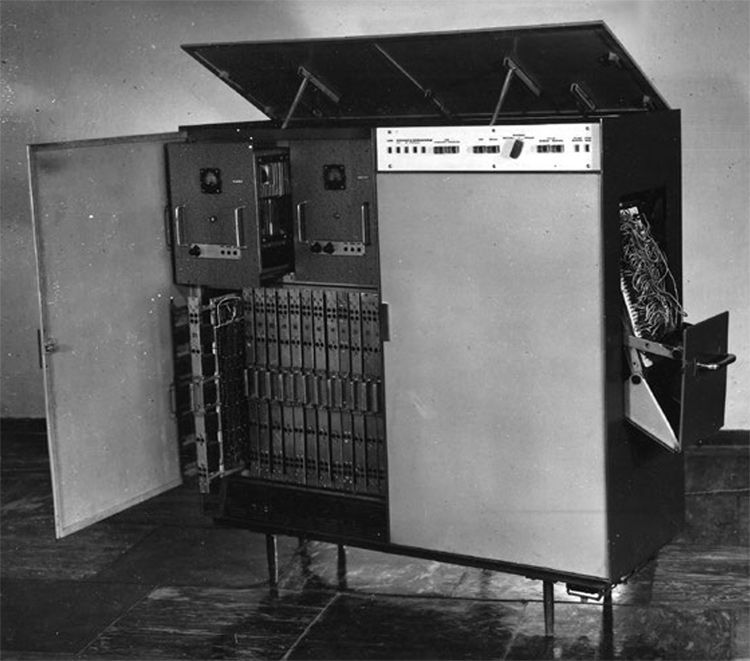
The first Lithuanian computer “Rūta”
By 1974, a total of 702 Lithuanian computers had been manufactured and used for the automation of accounting calculations at various institutions. Later versions of the Lithuanian computer were much more sophisticated, with hard disks and other external devices, and the possibility of connecting via telephone lines for data transfer. This made Lithuania a leader in the Soviet Union in terms of computing machines for processing large amounts of data in accounting offices.
The beginning of the internet on the roof of the Parliament building
After Lithuania regained its independence and the Soviets tried to suppress the media after the events of 13 January 1991, it was necessary to use electronic channels to spread the message about Lithuania. For this purpose, a satellite dish was built on the roof of the Parliament (Seimas, formerly the Supreme Soviet) building.
Lithuania’s first connection to the internet was established in 1982 when Moscow was given access to European and American computer networks; however, free and independent connection, which was no longer under the control of the Soviet Union’s security services, was only possible when a satellite link was set up with the University of Oslo.
The operations of the 10 October 1991 after the completion of the satellite link and the independent connection to the internet via the Nordic computer network NORDUnet. This enabled the academic community and the Parliament of the country that had declared independence to access the internet and send information about the events happening in Lithuania.
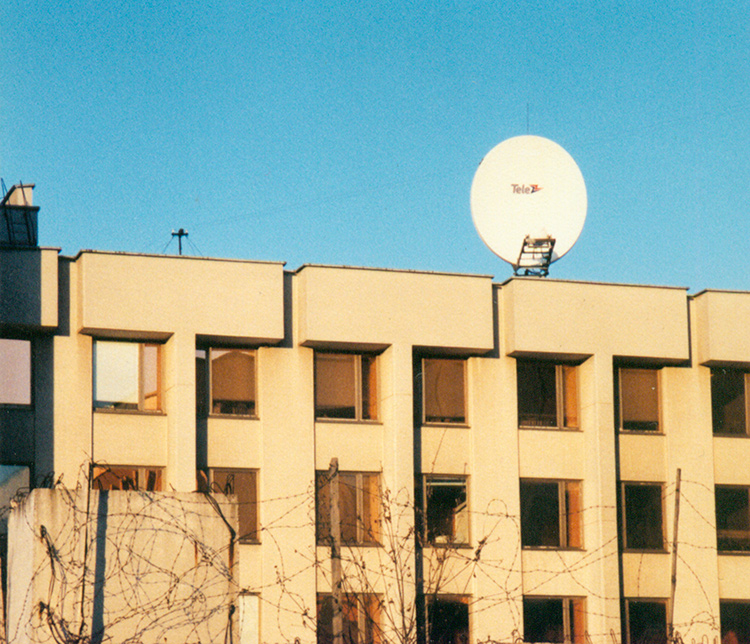
Satellite Internet antenna on the roof of the Parliament (Seimas)
LITNET connected the first internet network in Lithuania
After the connection to the internet, the initiative of Professor Laimutis Telksnys began the development of LITNET, the Lithuanian Research and Education Computer Network. In 1992, the first 64 Kbps intercity communication channel using the x25 protocol was established between Kaunas University of Technology and Vilnius University and the Institute of Mathematics and Informatics. Later, the network speed was increased to 2 Mbps.
The former head of the LITNET Control Centre Dr. Rimantas Kavaliūnas recalls that there were many concerns at the time about whether it would be possible to align the Soviet systems to the Western ones.
“Most experts were convinced that Soviet systems would not be compatible with Western data transmission systems. But Zenonas Bedalis, who installed the LITNET network, proved that digital data transmission was possible via the Soviet lines. This is how three Lithuanian academic institutions were connected by digital data transmission channels”, recalls Dr R. Kavaliūnas.
Although LITNET was ready to introduce the TCP/IP protocol as early as 1993, it was done only in 1994. According to Dr. Kavaliūnas, this internet-based protocol, which is still in use today, was recognised by the major telecommunications companies as the most suitable for the internet relatively late. The global debate lasted until 2000 when the TCP/IP network protocol was generally accepted.

The first computers and servers
Today, more than 1000 organisations use the internet provided by LITNET. The Lithuanian Research and Education Computer Network LITNET connects the computer networks of research, academic and educational institutions and provides high-speed data transmission, wireless access, e-identification, cloud computing, IT security and other services.
There would be no Lithuanian internet without the .lt domain
When an independent internet network was operating, websites and emails needed an address that identified Lithuania. On 3 June 1992, the .lt top-level domain was created online at the request of the University of Oslo, with the support of the Government of Norway. In 1994, the administration of the domain was transferred from the University of Oslo to Kaunas University of Technology.
Former Head of KTU Computing Centre and LITNET Board Member Professor Aleksandras Targamadzė assures that he made great efforts to transfer the administration of the .lt domain from Oslo to Kaunas.
“The events of January 13 have shown the importance of independent communication bypassing the Soviet structures. When I was the head of KTU Computing Centre from 1991, there was a certain struggle with the Norwegians, who created the .lt domain, for independent administration of the domain in Lithuania. Some people wanted for the external maintenance of the .lt domain to be continued. However, we argued that the Lithuanian domain should be in Lithuania”, - prof. Targamadzė recalls the first steps of the .lt domain.
According to the professor, in 1994, after the introduction of the IPv4 protocol in the LITNET network and the transfer of the .lt domain administration to KTU, very rapid development of the internet began in Lithuania.
The first .lt domains
Shortly after the creation of the .lt top-level domain in 1993, the first second-level domains mii.lt, ktu.lt and vu.lt were registered. At that time, only academia, public institutions and companies could have internet addresses.
The holder of the first registered mii.lt second-level domain, the Institute of Data Science and Digital Technologies at Vilnius University (VU DMSTI), has retained the domain to this day, even though the independent Institute of Mathematics and Informatics, represented by mii.lt, no longer exists as it has been merged with the University.
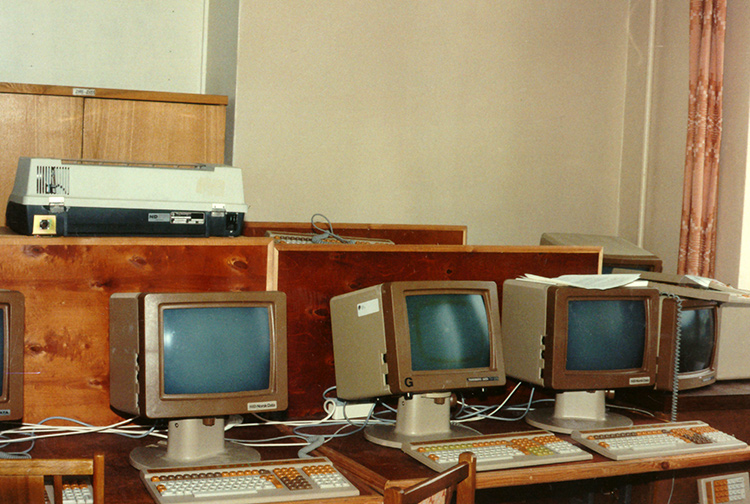
The first computers
Deputy Director of VU DMSTI Dr. Saulius Maskeliūnas states that it was very important for the institute to keep mii.lt, the first Lithuanian domain that is historically significant for the Lithuanian internet.
“The first Lithuanian domain mii.lt was created by the innovative computer networking laboratory led by Petras Šulcas. Together with Professor Laimutis Telksnis, they organised the first internet connection independent of Moscow by installing a satellite dish on the roof of the Parliament (Seimas). A website containing basic information in English about Lithuania, “Lithuanian Home Page”, was published at the address neris.mii.lt. This opened up a free way abroad via the internet, and the institute aims to preserve this important history of Lithuania’s independence for future generations and use the first Lithuanian domain to present the science of digital technologies,” emphasises Dr. S. Maskeliūnas.
The use of the internet prompted the growth of the .lt domains
Although the first internet was extremely slow and unstable, the number of internet users connected to the network was steadily increasing. Internet connections were made via analogue modems over telephone lines, with internet speed as low as 56 kbps. It was not until 2001, when the “Lietuvos telekomas” launched an ADSL technology-based internet service, that the data download speed increased to 512 Kbps. In addition, emerged a large number of internet service providers using wireless connections, antennas and relays on the roofs or chimneys of apartment buildings.
Since 2006, optical fibre internet has been available to home users at speed of up to 100 Mbps, and today, optical fibre internet service plans offered by providers ensure a high speed of up to 1 Gbps.

The first computers and servers
Director of the Radio Communication Department at the Communications Regulatory Authority Dr. Augutis Čėsna believes that the mass consumption of the internet in Lithuania started with the introduction of mobile internet based on third generation UMTS (3G) technology.
“Around the year 2000, preparations were made for the introduction of the third generation mobile technology UMTS. At that time, it was clearly stated that this was the generation for a wireless internet connection. Subsequently, the importance of the internet component in mobile technology has only increased. The fourth generation of mobile communications, LTE (4G), was dedicated exclusively to data transmission, leaving voice and TXT transmission as a separate network niche. Now, we are introducing the fifth mobile generation (5G), which is designed for ultra-high-speed mobile internet and Internet of Things,” Dr. Čėsna reviews the evolution of the mobile communication generations and their importance for the development of the internet.
In 2006, 3G communication services were launched in Lithuania, providing reasonably comfortable internet speed on mobile devices. In 2011, 4G radio-based internet services were launched. 4G technology allows data to be transmitted at the speed of up to 120 Mbps, while the more advanced 4G+ technology offers a speed of up to 330 Mbps.
Head of KTU Internet Service Centre DOMREG Tomas Mackus assures that the rapid growth of internet connection speed and steady increase in the number of internet users have prompted the creation of Lithuanian digital content and e-services. This required a plethora of addresses - .lt domains for access to the Lithuanian websites and portals. Due to the growing demand, the .lt domain registration process was liberalised in 2000, allowing natural persons to create domains.
“The internet and its infrastructure have progressed a lot in these 30 years, and in the last 10 years, Lithuania has been among the leading countries in terms of internet speed in Europe, if not the world. Therefore, everything is related: as the speed of the internet and the number of users has increased, so has the number of companies that wanted to make their information publicly available using websites, which is particularly important for businesses that export their products. I would also point out that the growth of the .lt domain was influenced by the dot-com bubble, which peaked around 2000, after which a good domain name started to be perceived as an investment asset,” notes T. Mackus.
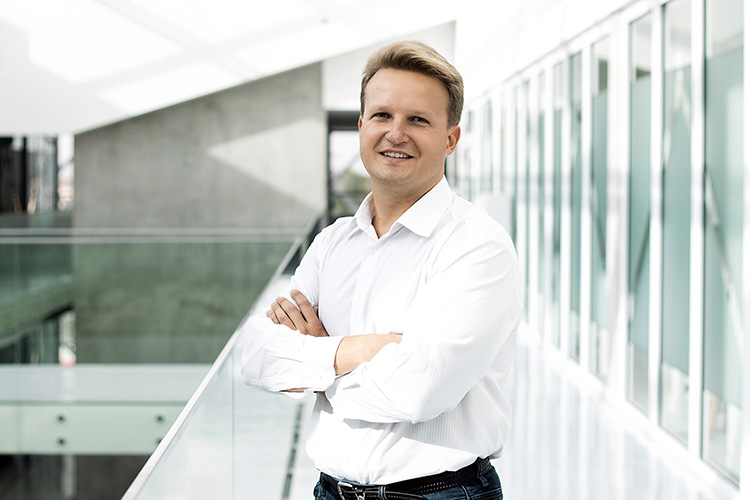
Tomas Mackus, Head of KTU Internet Service Centre
According to him, the internet started as an experimental tool for the military and scientists, then, with the development of high-speed mobile and optical fibre internet, it became an indispensable means of communication for everyone. The internet’s significant impact on public life has led to increased regulation by public authorities and self-regulatory mechanisms by international internet organisations. In 2007, the procedural regulations of the Lithuanian national .lt domain came into force. In 2009, a total of 100 000 .lt domains were registered and the threshold of 200 000 domains was reached in 2020.
The first completely Lithuanian domains
Considering that the “birthplace” of the internet was the United States of America (USA), where a four-node network between the Universities of Los Angeles, Santa Barbara and Utah and the Stanford Research Institute was connected for the first time with 50 Kbps lines in 1969, and the first domain symbols.com was registered in 1985, it was only natural to use Arabic numerals for the IP addresses and the letters of the Latin alphabet for the domain names.
According to the Head of KTU Internet Services Centre T. Mackus, when the internet spread outside the USA, there were problems in adapting both the Domain Name System (DNS) and computer and server software to the use of national characters.
“The Latin alphabet and Arabic numerals were a common method of encoding computer programs and network addresses. With the growth in the number of internet users, especially in regions such as Asia and Africa, there was a natural need for people who do not use the English language to use their own language. For this reason, there was a long search for technical solutions aiming to adapt domain names to the characters of other languages,” explains T. Mackus.
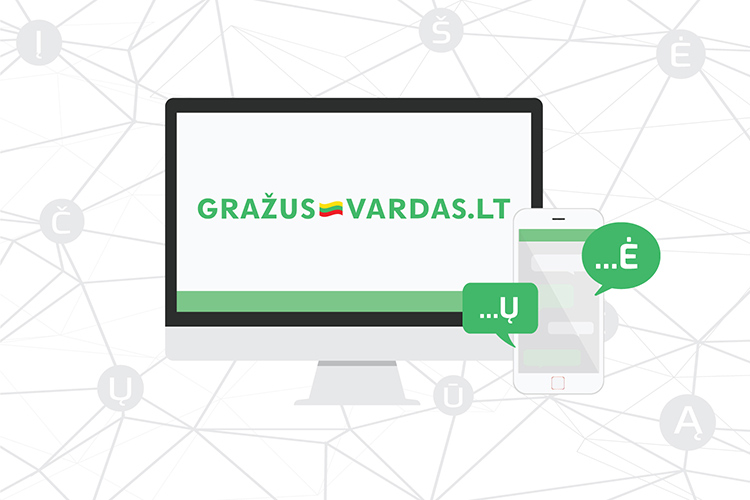
Competition for the most beautiful Lithuanian internet name
The possibility of creating domain names with diacritics of national languages was made available in 2003 with the approval of the IDN (Internationalised Domain Name) technical documents for encoding and displaying specific national characters by ICANN, the organisation coordinating the internet.
When in 2004 KTU installed a multilingual domain name system, which allowed the creation of the .lt domain names with the specific letters of the Lithuanian alphabet ą, č, ę, ė, į, š, ų, ū, ž, the first IDN domains were immediately registered: baldųnamai.lt, židiniai.lt, šildymas.lt.
Lithuanian language is a necessity in information technologies
Chairman of the State Commission of the Lithuanian Language (VLKK) Audrys Antanaitis thinks that IDN domains are significant for the Lithuanian language because the prevailing incorrect spelling was harmful to public literacy and damaged the language. This problem has persisted to the present day, as the majority of the .lt domains are still registered with incorrect spelling. The technical possibility to use the specific Lithuanian characters in the .lt domains has been available for 18 years.
“Currently, the Lithuanian language in information technologies is at the heart of language policy. It is important because Lithuanian is the national language used in society and public services are provided in Lithuanian. Do we want to have public e-services and software in Lithuanian? In my opinion, it is necessary, and the state must allocate resources for this goal. It is an expensive treat but there is no other way.
A language reflects thinking, conveys information, helps us to comprehend the world, and pass on our perception, experience and traditions to the next generation. If we use another language or incorrect language, we will pass on the experience that is not uniquely our own and damage our culture. It would only be a matter of time before the Lithuanian language would only be used for unofficial affairs.
Now, information technologies are the same as book publishing in the 16th century. We, the Lithuanians, were harmed at that time because in the 16th century we did not publish any Lithuanian books on a massive scale; there were only a few books by Mažvydas, Daukša, Kleinas and other authors, but the main language in use was not Lithuanian. I hope so much that we will not repeat the same mistake”, emphasises Chairman of the VLKK A. Antanaitis.
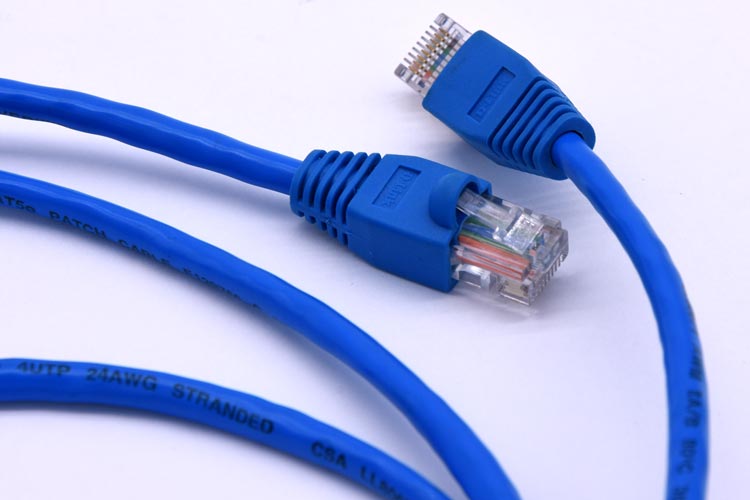
Internet and local area network (LAN) cables
To support the use of the Lithuanian names in domains, this year, KTU Internet Service Centre DOMREG has introduced artificial intelligence (AI)-based domain name generator. If the preferred Lithuanian domain name is unavailable, the system suggests alternative options of related names. The generation of the names is automated, using available synonyms of the given word, changing their form and/or searching for related words in corpora.
What is the future of the internet?
Director of “Infobalt”, an association of information technology and communications companies, Mindaugas Ubartas believes that without high-speed internet we would not have survived the coronavirus pandemic when we were all locked up; however, neither communication with each other nor businesses stopped developing.
“The war in Ukraine will accelerate digitisation even more and we will do it better than we have done so far when we thought that the internet would always be operating. Now, we will have to do resilient digitisation, facing the threats of war, as well as in the cases of power cuts.
I believe that, both in business and in the country, we will develop more resilient information systems that can be quickly restored from copies, or even run synchronously. I think that segmented infrastructure and cloud solutions will become more and more popular, and the consumption of e-services will continue to grow rapidly,” states M. Ubartas.
The buzzwords “blockchain” or “Metaverse” are often mentioned when talking about the new transformations of the digital economy. Candidate for the position of Deputy Secretary-General at the International Telecommunication Union Tomas Lamanauskas believes that while these technologies are interesting, the pragmatic application of digital technologies in everyday life is even more important.
“More attention should be paid to how digital technologies are applied. There should be complete digitisation of businesses: from logistics centres and factories that can be fully automated to all services that can be delivered electronically.
We will also have digital houses based on a combination of different technologies, an environment that will increasingly become digitalised, controlled and able to self-control according to our daily needs and habits.
Finally, the future of wearable devices is also promising. For example, they will enable us to measure our health parameters and adjust our lifestyle.
I think that in the future, the digital environment connected by the internet will surround us even more and accompany us everywhere, from everyday life to digital manufacturing and business,” predicts T. Lamanauskas.
Published 2022-07-11
